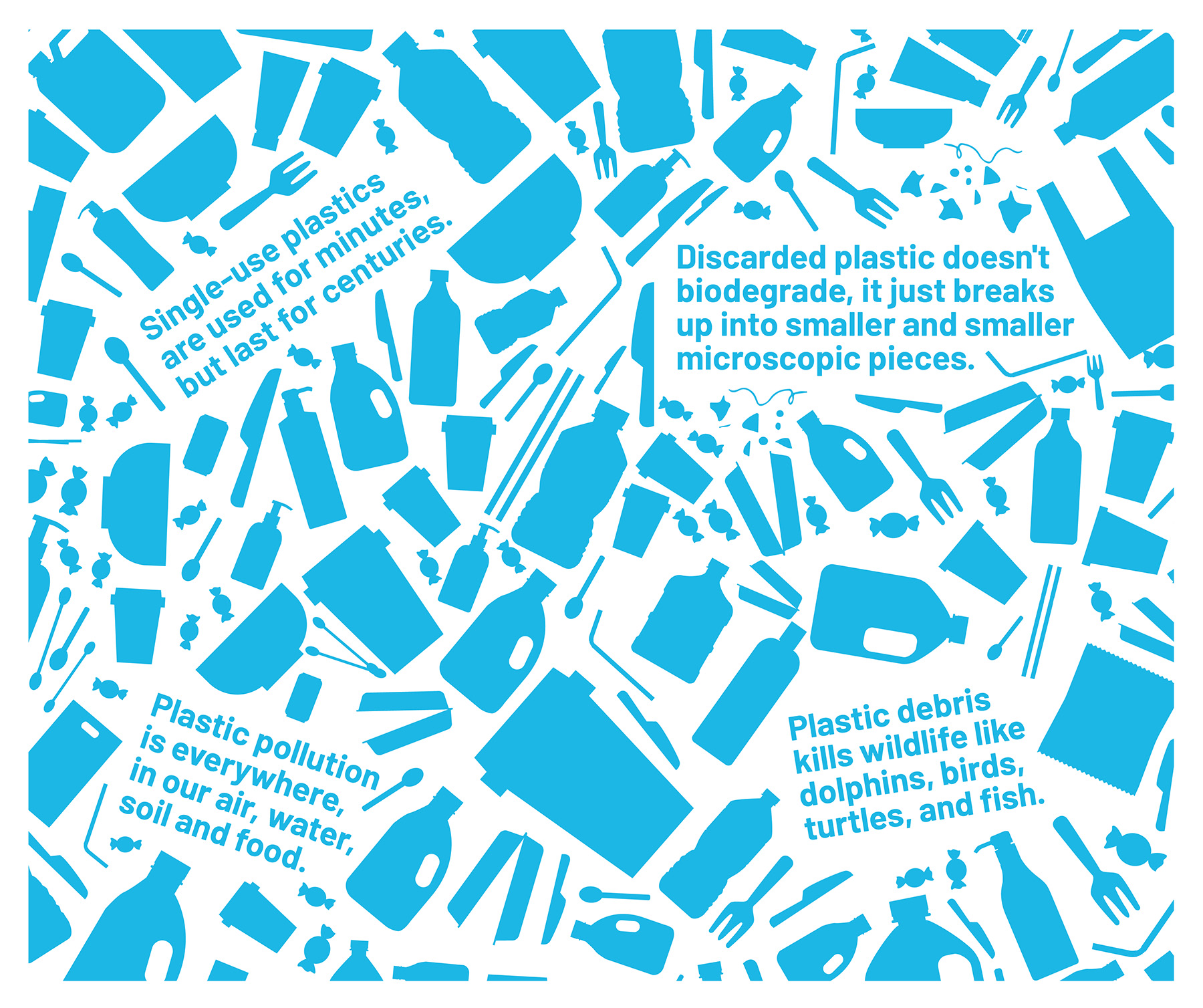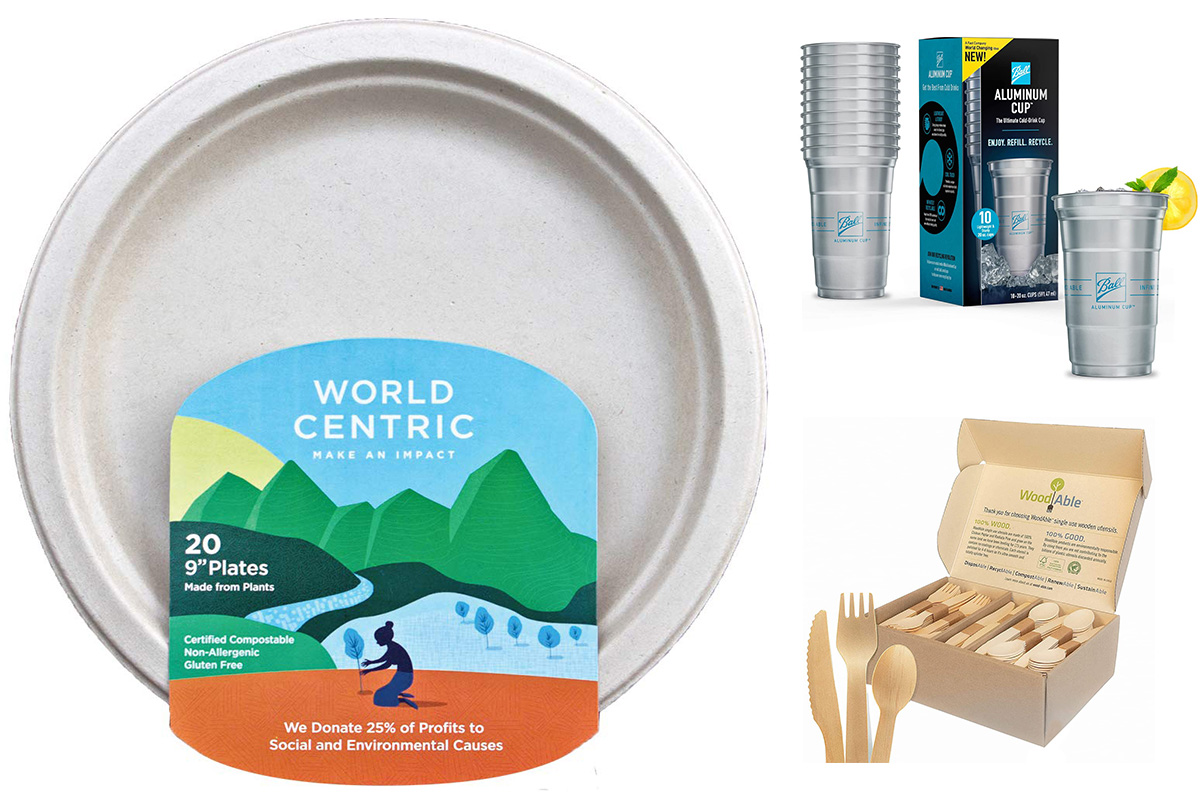Watch Your Waste
In our fast-paced society, single-use plastic is a shortcut to convenience. From plastic bags and packaging to beverage bottles and to-go containers, single-use plastics are ubiquitous. We’re offered plastic items we don’t really need or will only use briefly, compared to the centuries those plastics sit in a landfill or, worse, wind up in the environment. Stop plastic pollution at its source by saying no to single-use convenience plastics and making easy swaps for durable or compostable substitutes when dining out and shopping.

We’ve sifted through all sorts of tips for ditching single-use plastics to find the ones that are easiest and most effective. In many cases, the solutions are free—you just make a small tweak to the way you do things. There are also many low-cost solutions that only require an easy substitution of a more durable container, which you may already own.
Cost: $0-20
Take-out food packaging is the poster child of pernicious plastic waste, comprising the majority of single-use plastic pollution. In a 2021 study of marine litter, 44% of the 12 million pieces collected were linked to take-out food products: single-use bags, bottles, food containers, food wrappers, and utensils.
How do you refuse and reduce plastic utensils, cups, bags, and containers?

Cost: $0-20
Reducing waste starts with how you shop. As consumers, we typically just buy what’s available, and the non-discriminating shopper is guaranteed to come home with loads of plastic. But we can make smarter choices to reduce single-use packaging by shopping in a more strategic way and using a toolkit. Take these steps one at a time—forming new buying habits takes planning and persistence. Your refusal to accept plastic bags and packaging will help drive businesses to offer better alternatives.
Support local grocery stores like these where you can buy bulk staples and loose vegetables:
* Note: These grocers are Sarasota County Certified Green Business Partners committed to reduction, reuse, and conservation practices.
Option 1
Love the convenience and selection of Amazon.com, but concerned about all that packaging?
Watch: Tame the wrap rage – what is frustration free packaging?
Option 2
Some call it the Amazon of eco-friendly shopping. At EarthHero.com you can peruse more than 200 brands for thousands of products designed, manufactured, packaged, and shipped in ways that reduce pollution and waste. Use the left-side menu to select products that meet your personal sustainability criteria, from ingredients and materials to sourcing and packaging.
Other ideas for eco-friendly online shopping where your purchase and the packaging is plastic free.
Host your next event without producing a mountain of trash using this Sustainable Event Guide from Sarasota County UF/IFAS Extension and Sustainability.


Is it possible to live a plastic-free modern life? Probably not—there are some uses of plastics that are life-saving, where there is no substitute, and where plastic actually has a lower overall environmental impact compared to alternatives. Consider plastic-free substitutes for these household, health, and beauty products: K-cups, tea bags, plastic wrap, Tupperware, cutting boards, toothbrushes, razors, makeup, cleansers, soaps, toys, trash cans and liners, clothing, diapers, feminine hygiene.
Find out what’s happening and join in with our comprehensive community events listing.
Look for this class
Single-use plastics make up 11% of what Americans throw away, but only 3% of what we recycle. We could do better, but much of the plastic dropped in recycling bins isn’t being recycled. When the price of oil drops, it becomes far cheaper to make virgin plastic than to buy recycled plastic for manufacturing. Further, many plastic materials degrade each time they are processed and can only be recycled a few times. Without a profitable resale market, U.S. recycling companies landfill the material or sell it to other countries, primarily in Asia, where the waste is landfilled, incinerated, or escapes into waterways to fuel the ocean plastic pollution crisis. Learn more about why plastic recycling is broken and what we can do to fix it. Hint: manufacturers and supply chains need to take responsibility for reducing wasteful packaging.
Plastic utensils and straws are a problem child for plastic recycling and usually end up as plastic pollution. In theory, they should be recyclable, but three obstacles stand in the way. First, they are made from a variety of different plastics. Some are commonly recycled (PET–#1 plastic and polypropylene–#5 plastic) and others not (polystyrene–#6 plastic); since they’re not labeled there’s no way to know. Second, their weird shape can jam the sorting machinery at the materials recovery facilities. Finally, even if accepted for recycling (they are not in our region), they are more likely to be shipped to Asia instead of recycled in the United States. The best solution is to stop forking around with plastic and carry reusable or compostable utensils instead.
Biodegradable plastic is not a win – yet. Most biodegradable plastics sold as cups, plates, and utensils are made from some compostable material mixed with PLA (polylactic acid) – a durable plant-based plastic polymer made from corn starch or sugar cane. It is biodegradable, but only under certain high-heat conditions found at industrial-grade composting facilities that don’t exist in our area. If you throw that PLA cup or fork in the trash or your compost bin, where it will never be exposed to conditions that trigger biodegradation, it will sit there for decades or centuries, much like ordinary plastic pollution. A new generation of bioplastics composed of PHA (polyhydroxyalkanoate) made from canola oil are biodegradable in marine water and soil, and thus can be certified as home compostable . Because they break down so easily, PHA products are limited to plastic bags, wraps, and straws. Although bioplastics avoid the use of fossil fuels, they are not a solution for the waste piling up from single-use plastics.
Here are 10 steps you can take to improve the sustainability of your business:
By setting specific goals and implementing targeted initiatives, you can make meaningful strides towards sustainability while working towards becoming a Sarasota County Green Business Partner.
Submit your waste-related question to local experts. If selected, they will answer and feature your question on our FAQ. Not all questions will be answered.
Mind if we stay in touch?
We'll send you our free Toolkit Quick Reference Guide.
We'll never spam you or share your info. Unsubscribe at any time.
This site protected by reCAPTCHA and the Google Privacy Policy and Term of Service apply.
©2024 Science and Environment Council of Southwest Florida | Site by Chariot.